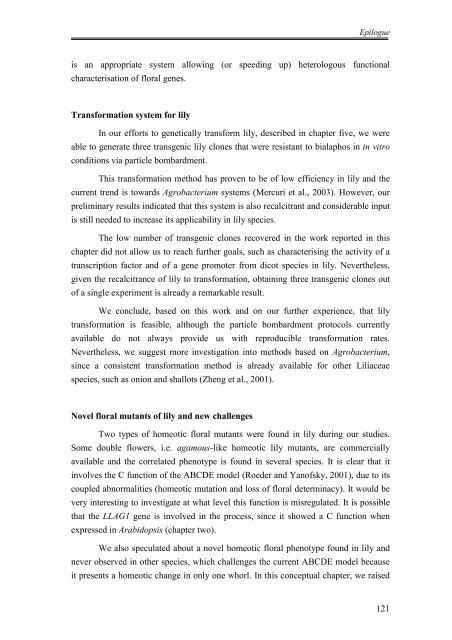Flower development of Lilium longiflorum - The Lilium information ...
Flower development of Lilium longiflorum - The Lilium information ...
Flower development of Lilium longiflorum - The Lilium information ...
Create successful ePaper yourself
Turn your PDF publications into a flip-book with our unique Google optimized e-Paper software.
Epilogue<br />
is an appropriate system allowing (or speeding up) heterologous functional<br />
characterisation <strong>of</strong> floral genes.<br />
Transformation system for lily<br />
In our efforts to genetically transform lily, described in chapter five, we were<br />
able to generate three transgenic lily clones that were resistant to bialaphos in in vitro<br />
conditions via particle bombardment.<br />
This transformation method has proven to be <strong>of</strong> low efficiency in lily and the<br />
current trend is towards Agrobacterium systems (Mercuri et al., 2003). However, our<br />
preliminary results indicated that this system is also recalcitrant and considerable input<br />
is still needed to increase its applicability in lily species.<br />
<strong>The</strong> low number <strong>of</strong> transgenic clones recovered in the work reported in this<br />
chapter did not allow us to reach further goals, such as characterising the activity <strong>of</strong> a<br />
transcription factor and <strong>of</strong> a gene promoter from dicot species in lily. Nevertheless,<br />
given the recalcitrance <strong>of</strong> lily to transformation, obtaining three transgenic clones out<br />
<strong>of</strong> a single experiment is already a remarkable result.<br />
We conclude, based on this work and on our further experience, that lily<br />
transformation is feasible, although the particle bombardment protocols currently<br />
available do not always provide us with reproducible transformation rates.<br />
Nevertheless, we suggest more investigation into methods based on Agrobacterium,<br />
since a consistent transformation method is already available for other Liliaceae<br />
species, such as onion and shallots (Zheng et al., 2001).<br />
Novel floral mutants <strong>of</strong> lily and new challenges<br />
Two types <strong>of</strong> homeotic floral mutants were found in lily during our studies.<br />
Some double flowers, i.e. agamous-like homeotic lily mutants, are commercially<br />
available and the correlated phenotype is found in several species. It is clear that it<br />
involves the C function <strong>of</strong> the ABCDE model (Roeder and Yan<strong>of</strong>sky, 2001), due to its<br />
coupled abnormalities (homeotic mutation and loss <strong>of</strong> floral determinacy). It would be<br />
very interesting to investigate at what level this function is misregulated. It is possible<br />
that the LLAG1 gene is involved in the process, since it showed a C function when<br />
expressed in Arabidopsis (chapter two).<br />
We also speculated about a novel homeotic floral phenotype found in lily and<br />
never observed in other species, which challenges the current ABCDE model because<br />
it presents a homeotic change in only one whorl. In this conceptual chapter, we raised<br />
121














